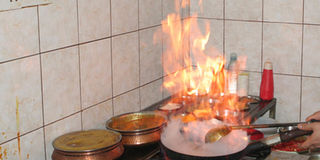Prime
Good vs bad cooking oil for your foods

Cooking oil that has a lower smoking point is best for cooking foods of high temperatures like baked foods. PHOTOS BY ISMAIL KEZAALA.
Cooking oil may make food tastier, and its ingredients could protect delicate body organs like the heart and liver, however, if one does not pay attention to the type and amount of oil they take in, it could harm their health, writes Christine Katende.
A friend of mine had a stomachache three weeks back. She did not know what the cause was. She only found out what had caused it after she went for treatment. The doctor told her that she had eaten contaminated oil. Choosing the cooking oil with which to fry your foods is not just a matter of picking a jerrycan of the stuff from any shop without knowing if it is the best type to use.
According to Mr Richard Muhumuza, a dietitian working with Uganda Dietetic Association under the Ministry of Health, the best type of cooking oil depends on the smoking point (the temperature at which a fat or cooking oil begins to break down into glycerol and free fatty acids) and the fat content. Different cooking oils have different smoking points, but when it comes to nutrition, “the shorter the smoking point the faster the oil cooks. The longer the smoking point the poorer the oil.”
Mr Muhumuza adds that cooking oil that has a higher smoking point is best for cooking foods of high temperatures like baked foods. One thing to note also is that essential fatty acids are vital for good health. Without some fats in our diets, we cannot absorb the fat-soluble vitamins A, D, E and K. There are various cooking oils on the market and below we look at some of them:
Olive oil
Olive oil is an oil obtained from the olive, a traditional tree crop of the Mediterranean Basin. The oil is made from the crushing and then subsequent pressing of olives. All types of extra-virgin and virgin oils are made from the first pressing of the olives, which removes about 90 per cent of the olives’ juice. Chemicals and high heat are not allowed in the production of extra-virgin or virgin oils. No further processing or refining occurs after the pressing process. Neither extra-virgin nor virgin oils are allowed to contain any refined olive oil.
Advantages
It burns at a shortest time thus having a good smoking point.
It is low in saturated fats and high in unsaturated fats.
It is a medium in which all soluble vitamins are absorbed.
It provides energy.
Disadvantages
It is more expensive compared to any other type.
It is not good for making foods that need high temperatures.
Corn cooking oil
This oil is made from the germ (seed) of the corn kernel. It is almost tasteless and is excellent for cooking because it can withstand high temperatures without burning, for examples include Elianto cooking oils.
Advantages
It is high in polyunsaturated fat.
It is low in saturated fat.
It is high in vitamin E.
It is a good source of vitamin A since most of it is fortified.
It is good for frying since it can withstand high temperatures.
Disadvantages
It is dangerous to use when overheated.
Sunflower oils
This type of oil is made from sunflower seeds. Sunflower oil is pale yellow in colour, has a bland flavour and is considered good, all-purpose oil, for examples include Sunseed cooking oil.
Advantages
It is low in saturated fat and high in polyunsaturated fat.
It is good for preparing salad dressings, deep-frying and pan-frying.
Vegetable cooking oil
This is an all-purpose type of oil which is a blend of refined oils made from vegetables, nuts and seeds. Most vegetable oils are made from soybeans. According to www.zimbo.com, this type of oil is designed to have a mild flavour and a high smoking point. It is recommended for deep-frying, pan-frying, sauteing and baking.
Advantages
It is high in monounsaturated fat.
It is high in polyunsaturated fat.
It is low in saturated fat.
It is usually less expensive compared to the rest.
Palm oils
Despite palm oil being rich in beta carotene, Vitamin E and having a high smoking point, it is also rich in saturated fatty acids. This is why Mr Muhumuza says that it may cause controversy when it comes to being recommended as good oil to consume.
Most studies may discourage it based on its richness in saturated fat; however some studies have urged that this may be the best oil to consume as it is well balanced in monounsaturated (40 per cent), polyunsaturated (10 per cent) and saturated fat (50 per cent). “Because of the controversy, I would recommend one to use other proven oils such as olive and sunflower oil to avoid chances of taking saturated fatty acids,” the nutritionist says.
At the end of the day, if you want to choose what oil to use, Mr Muhumuza says that what you should look at is its fat content. He adds that while one can have food without using cooking oil, fat free foods or products help produce insulin in the body. “The more carbohydrates one takes the more insulin is produced in the body and the more insulin produced in the body the more one gets hungry,” he says.
“With that, a person has to consume about 70 grams of oil a day,” he says, adding that, oil has to be measured with equipment like graduated tins and spoons which include tea, table and dessert spoons depending on the amount of food one is going to prepare. A tablespoon of cooking oil contains 14 grams of fat. He says that cooking oil brings about satiety and palatability hence protecting the delicate body organs such as the heart and liver.
Dos and Don’ts
1. Never add fresh oil to the fried oil. The leftover oil can be used in other preparations but should not be reused for frying.
2. Store oil in an airtight container in a dark place away from light.
3. Minimise use of oils rich in saturated fats.
4. Pay attention to expiry dates of the oil as rancid (expired oil) can cause serious medical complications.
5. To dispose of used cooking oil, carefully pour cooled oil into a strong sealable container, such as an old plastic jar with a lid or old coffee can. (Avoid using breakable glass jars.) If the amount of oil is small, place the filled, sealed jar in the trash. Dispose of large amounts of cooking oil by taking it to the local landfill.
6. Do not pour cooking oil down the kitchen drain. Even small amounts will eventually clog the plumbing.
• Remember to always wait until cooking oil has cooled completely before handling.
• Look out for the following from the label.
• The type of oil (vegetable or animal origin). Vegetable oil is usually preferred.
• It should be cholesterol free.
• It should be very low in transfat.
• Pay attention to whether it’s flavoured or not and pick what is desirable.
• Choose oils high in unsaturated fat (mono and polyunsaturated).




